How to Draw Hands
... a study of detailed hands
This is my version of Ella Fitzgerald. For a description of how to draw hands in detail, see the close-up below.
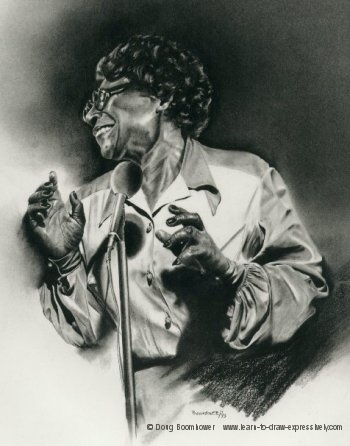
I used a variety of photographic references along with my own personal style to come up with this composition.
The hands are caught in a frozen moment in time so that I can add detail. The gesture of the hands imply that they are on the verge of movement.
Ella Fitzgerald, 1917 - 1996
Known in the jazz world as the "First Lady of Song."
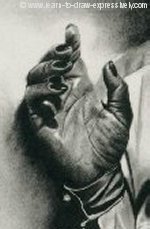
Note the lines and the lights and darks in the palm of her hand.
If you look carefully at the main creases in her palm, you'll note that each crease is accompanied by a dark area and a subtle light area.
The "meaty" lower part, where the thumb joins the hand, is differentiated from the rest of the palm by a different pattern of lights and darks.
Note that each finger casts its own individual shadow across the palm. A highlighted area was created to imply a light shining between the fingers.
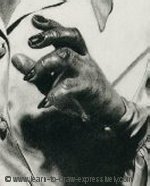
Note the highlights and creases in the knuckles. The highlights in both hands were created with a kneaded eraser.
Note the close attention to the fingernails in both hands. I drew the fingernails with a charcoal pencilnd then I brushed them intensely in order to achieve the look of shiny nail polish.
That shiny surface is enhanced with highlights, which I created after the charcoal was applied. A kneaded eraser was used for the highlights.
More on How to Draw Hands
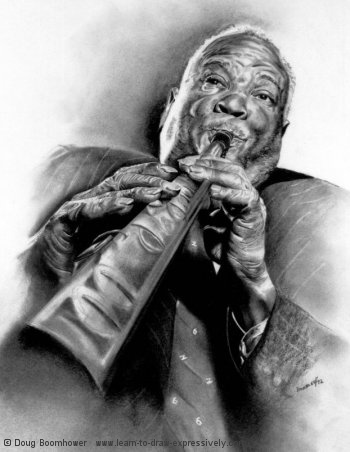
Sidney Bechet,
1897 - 1959
The earliest great jazz clarinetist.
This original charcoal drawing of Sidney Bechet is based on a photograph taken by the famous American jazz photographer, William P. Gottlieb.
These hands are a good example of how far you can go with charcoal technique in order to make things look real.
Both hands are a strong study in light and shadow.
Refer to the arrows below for the following points on how to draw hands in detail:
- Highlights where natural light falls between the fingers and across the palm of the hand. These highlights are emphasized against strong black shadows, which follow the palm of the hand.
- Each crease is accompanied by a highlighted area. That highlight is where the natural light falls. These strong creases have been created with a sharp HB charcoal pencil. Sometimes if those lines are too sharp, they are softened lightly with blending stumps. After I have established that line, I follow it with a sharpened kneaded eraser. This creates the accompanying highlight.
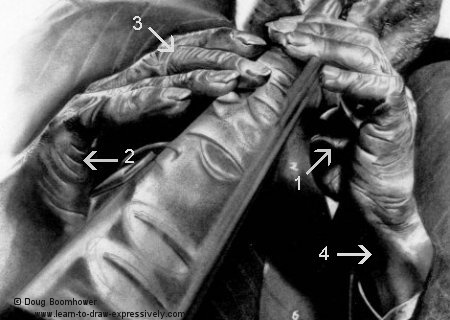
- Each crease and wrinkle in the fingers follows a similar pattern of alternating dark and light areas. Since this area is softer, I used a 3B charcoal pencil.
- Notice the tonal gradations and highlights in this area which imply the structure (tendons, bone) of the wrist.
Note the sharply delineated shadows under the fingernails, (particularly the hand you see on the left.) I used an HB pencil to get these sharp blacks. This adds clarity to the drawing of the hands, and also makes the hand look more three-dimensional.
These hands consist of sharp contrasts as well as softly blended areas. Most of the softer hand areas were done by lightly applying 3B charcoal, and then brushing it in.
The darkest shadows were done with 4B or 5B charcoal pencils. I block in the shadowed areas and then rub the charcoal into the paper using my finger or tissues. The trick here is to do it slowly and carefully so as not to lose control of the areas . . . the shadowed areas must remain clear.
When necessary, the edges of the shadows can be softened (using a brush), to blend subtly into the adjacent area.
Are you looking for more information on how to draw hands?
To search my site, enter your search term in the box below, and click on the Search button. (Google ads may appear at the top of the results page ... your search results will be just below.)
Return from How to Draw Hands in Detail to Home Page




